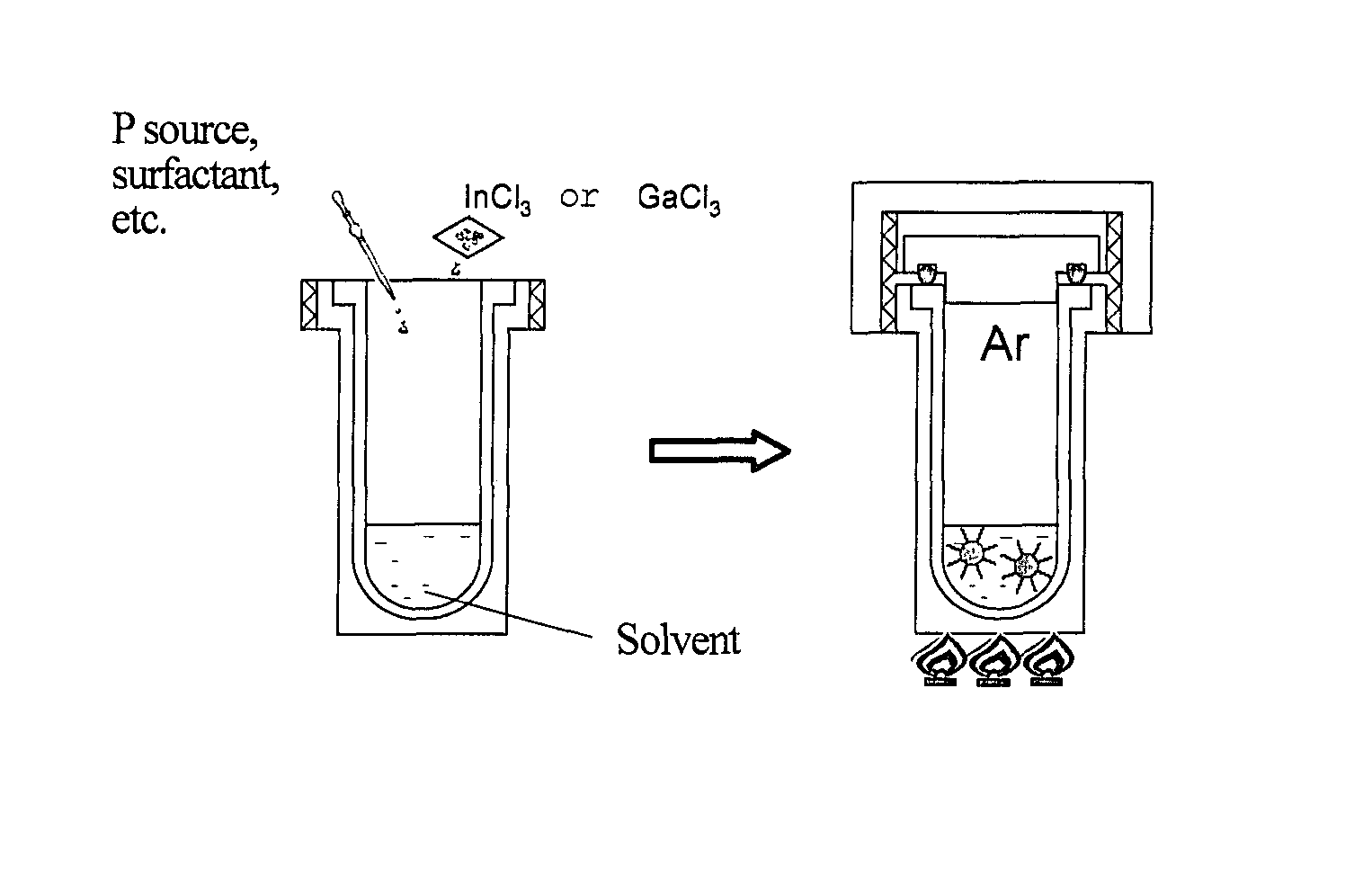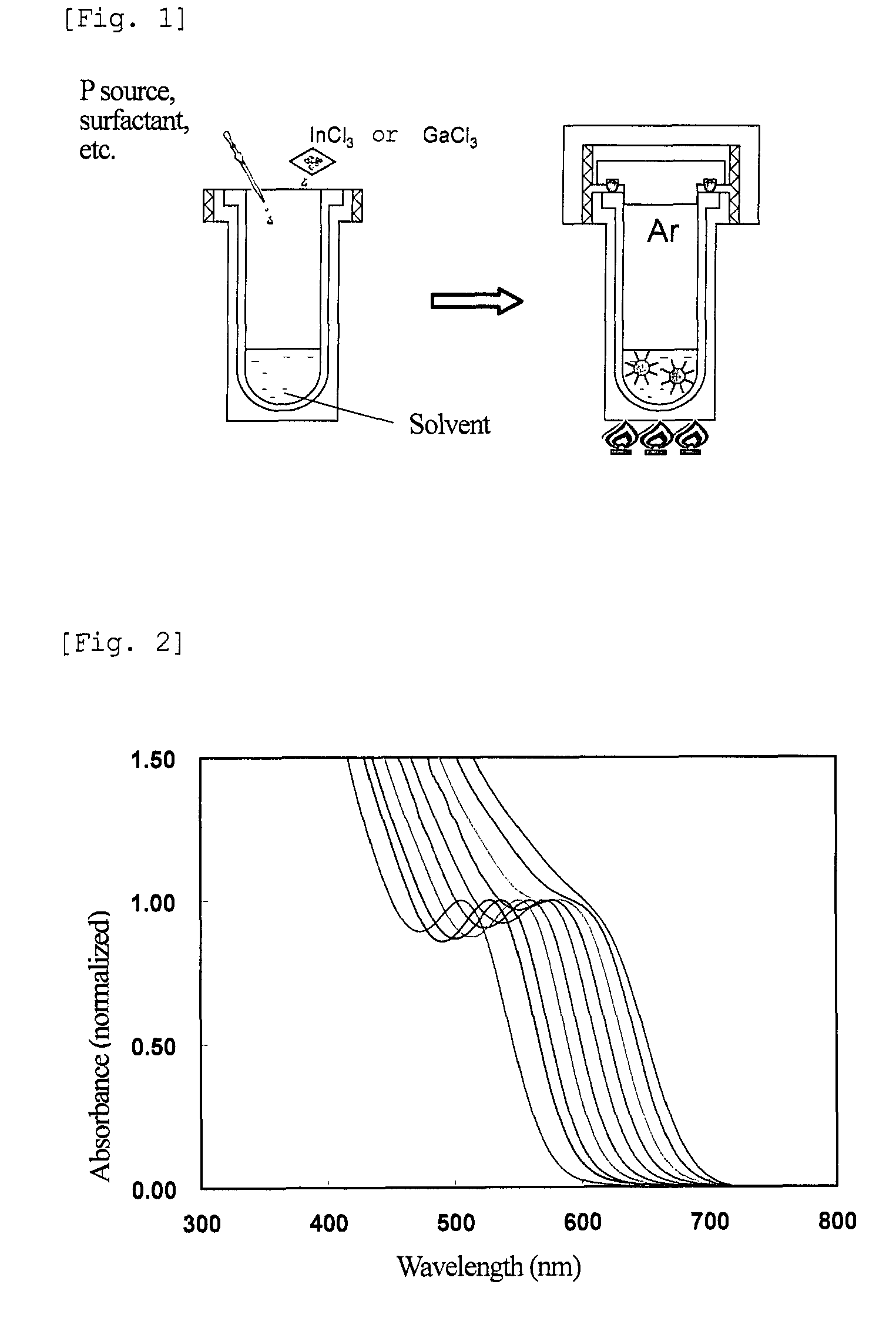Water-dispersible nanoparticles having high luminous efficiency and method of producing the same
a technology of nanoparticles and luminous efficiency, which is applied in the direction of liquid/solution decomposition chemical coating, discharge tube luminescnet screen, instruments, etc., can solve the problems of toxic metals in semiconductors with high pl efficiency, difficult to produce iii-v semiconductors, and unsatisfactory durability, etc., to achieve high pl efficiency, high pl efficiency, and high stability
- Summary
- Abstract
- Description
- Claims
- Application Information
AI Technical Summary
Benefits of technology
Problems solved by technology
Method used
Image
Examples
example 1
[0173](1) Process of Producing InP Nanoparticles
[0174]InP nanoparticles as a III-V semiconductor were prepared by the following method using a solvothermal method.
[0175]First, in a glove box having an argon atmosphere, 0.4 g of indium chloride (InCl3), 3 ml of trioctylphosphine ([CH3(CH2)7]3P, TOP) as a surfactant, and 2.5 g of dodecylamine (CH3(CH2)11NH2, DDA) were added to an autoclave. Further, 5 ml of toluene (C6H5CH3) was added as a solvent, and 0.5 ml of tris(dimethylamino)phosphine (P[N(CH3)2]3) was added.
[0176]The autoclave was transferred to an electric furnace, and maintained at 75° C. for 1 hour. The temperature was raised to 180° C., and nanoparticles were grown for 24 hours. FIG. 1 is a schematic diagram illustrating the synthesis of InP nanoparticles by the solvothermal method.
[0177]10 ml of toluene and 6 ml of methanol were added to the nanoparticle dispersion obtained by the above method. After ample stirring, the mixture was centrifuged for 10 minutes, and the trans...
example 2
[0195]InP nanoparticles were prepared as in step (1) of Example 1. Without performing the size-selective precipitation method, the InP nanoparticles were dispersed in an aqueous solution (ZT solution) in the same manner as in step (2).
[0196]Acetonitrile was added as a poor solvent to the nanoparticle-dispersed aqueous solution, and nanoparticle powders of different particle sizes were obtained by the size-selective precipitation method.
[0197]The different-sized powders were separately redispersed in the ZT solution according to the particle size. The dispersion was irradiated with UV light in the same manner as in step (3) of Example 1.
[0198]FIG. 6 shows the results of absorption spectra and PL intensity of the nanoparticles of different particle sizes after the above treatment. The numerals shown in FIG. 6 are the Sample Nos. shown in Table 2 below. The nanoparticles thus obtained were found to have an emission wavelength of 550 to 650 nm, and a PL efficiency of 30 to 55%.
[0199]Tab...
example 3
[0202]InP nanoparticles were produced according to step (1) of Example 1. Without performing the size-selective precipitation method, the InP nanoparticles were dispersed in an aqueous solution in the same manner as in step (2).
[0203]A large amount of methanol was added as a poor solvent to the nanoparticle-dispersed aqueous solution to suspend the solution. The suspension was centrifuged to obtain substantially all the nanoparticles as precipitates.
[0204]The powder obtained was redispersed in 2 ml of the ZT solution, and irradiated with UV light under the same conditions as in step (3) of Example 1. FIG. 7 shows absorption and fluorescence spectra of the nanoparticles before and after irradiation with UV light. The results show that the irradiated nanoparticles have a PL efficiency of 65% and an emission wavelength of 645 nm.
[0205]Further, the poor solvent was added to the irradiated nanoparticle aqueous solution to suspend the solution, and a nanoparticle powder of different parti...
PUM
| Property | Measurement | Unit |
|---|---|---|
| diameter | aaaaa | aaaaa |
| thickness | aaaaa | aaaaa |
| molar ratio | aaaaa | aaaaa |
Abstract
Description
Claims
Application Information
 Login to View More
Login to View More - R&D
- Intellectual Property
- Life Sciences
- Materials
- Tech Scout
- Unparalleled Data Quality
- Higher Quality Content
- 60% Fewer Hallucinations
Browse by: Latest US Patents, China's latest patents, Technical Efficacy Thesaurus, Application Domain, Technology Topic, Popular Technical Reports.
© 2025 PatSnap. All rights reserved.Legal|Privacy policy|Modern Slavery Act Transparency Statement|Sitemap|About US| Contact US: help@patsnap.com



